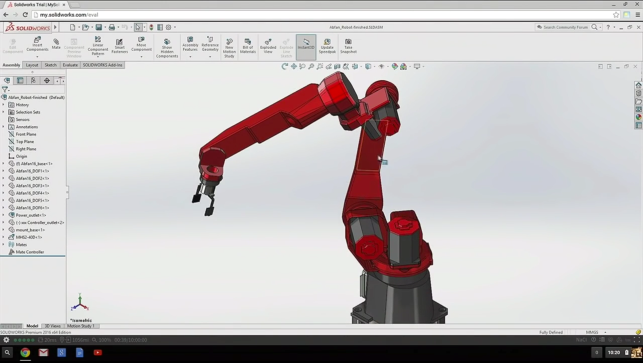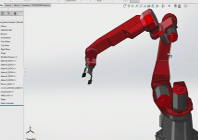
SolidWorks Online Edition running insidethe Google Chrome web browser
Being able to work from anywhere on any device is one of the most compelling arguments for new-generation CAD tools such as Onshape that run inside a web browser. But users of traditional CAD applications like SolidWorks and Solid Edge don’t have to switch camps to reap benefits.
Frame (previously called Mainframe 2) allows any Windows-based CAD tool to run in the cloud on a virtual workstation, while the designer controls it remotely on pretty much any device running an HTML 5 web browser. As all the processing is done in the cloud and only pixels are sent over the Internet, you don’t need a powerful workstation on your desk. This means you can run CAD on tablet, laptop or PC from anywhere with low-latency, high-bandwith Internet connection.
Frame’s service was first positioned to help CAD software developers get on board with the cloud delivery but more recently, the company has rolled out a pay-as-you-go service for end users. Plans start from as little as $10 per month.
With Frame’s rental model, you only pay for the hours you use and the capabilities of the virtual workstation (think CPU cores, GPU, memory and storage). This pay-per-use-model gives flexibility if you only want to use the service occasionally (working from home at the weekend or from a client’s office) or want to ramp up the spec when workflows get more hardware hungry (e.g. when rendering).
Getting data into the system is easy. You can pull CAD models directly from Dropbox and other cloud storage services. And with fast data centre to data centre connections, even sizeable CAD datasets can be transferred very quickly.
Frame also takes the pain out of collaboration. Rather than getting bogged down with user accounts and permissions, designers can share their unique session URL with other team members, who simply paste the link into a browser to instantly see your desktop CAD environment. They can even take control of the session with their own mouse and keyboard.
We first tried out Frame last year when its ‘CAD in the cloud’ service was still in beta. It’s fair to say we were very impressed, particularly in regards to how easy it was to set up. In less than 45 miniutes, we had downloaded and installed a trial version of Autodesk Inventor and were running software on a MacBook Pro inside a Firefox browser.
Even though we were in London and the data centre was in Ireland, the performance was excellent. There was no lag between moving the mouse and the cursor responding on screen.
Models rotated smoothly. There really was no discernable difference to using a local desktop workstation.
While we found setting up the system with trial CAD software to be very straightforward, bringing Frame into a commercial environment is likely to bring up some challenges, particularly when it comes to licensing.
We’re not just talking about technical issues here but also ensuring compliance with your CAD software’s End User License Agreement.
Frame acknowledges that there is some work to do here and recently produced a best practices guide for CAD to help users.
The PDF features practical advice on how to ‘onboard’ SolidWorks, NX, Solid Edge, Vectorworks, PTC Creo and Ansys Workbench and includes information on standalone and network licensing, as well as details of ports that may need to be opened to access license servers.
The guide appears to be a work in progress, with some applications having more-in-depth information than others. SolidWorks is the pick of the bunch as it also includes information on how to retain user-specific toolbar and software settings between sessions, which is an important consideration if you want that personal workstation experience. The good news is that Frame’s support team is on hand to help users get up and running with a variety of different tools.
The long-term goal for Frame is for the CAD software developers to certify and support its platform in the same way that they currently do for desktop and mobile workstations. This ‘seal of approval’ will likely be important for some design and engineering firms who want the assurance that they will be adequately supported by their CAD software developer.
While no CAD application certifications have been announced yet, it is clear that Frame does have industry backing.
This year both Siemens and PLM Software and Dassault Systèmes unveiled browser-based CAD delivery services that use the Frame platform.
Siemens offers a 45-day ‘streamed’ trial of Solid Edge Premium, which gives new users an incredibly easy way to try out the CAD software without having to install time-bombed software.
Meanwhile, Dassault Systèmes recently previewed the SolidWorks Online Edition, which SolidWorks customers will be able to access through the online portal, mysolidworks.com.
Nikola Bozinovic, founder of Frame, told DEVELOP3D that his company has done a lot of work on providing tight integration between mysolidworks.com and SolidWorks running on the Frame platform that will give users a ‘personalised experience’.
“We exchange information about who the user is and bring up, for example, a user’s specific files, so that the environment you come into is the same you had the last time you used the software, including most recently used files and your preferences and everything else,” he said.
While it is not yet clear how or when Dassault Systèmes will bring SolidWorks Online Edition to market, Frame has stated previously that it is capable of helping CAD developers create a complete cloud delivery business with software distribution through an app store, user management (complete with payment) and file linking to existing Product Data Management (PDM) or Product Lifecycle Management (PLM) systems. Frame is so much more than just a pixel streaming service.
Conclusion
With applications like Onshape and Autodesk Fusion 360, designers and engineers are starting to get used the idea of renting CAD software, so why not rent the workstation that runs it as well?
With Frame, that workstation happens to be in the cloud, so you also get a level of flexibility that you simply can’t get from a desktop machine.
While some design and engineering firms may ditch their desktop workstations altogether, we mainly see Frame being deployed as part of a hybrid local/cloud model. Use desktop workstations for nine-to-five work and the cloud patform when you need access to CAD putside of the traditional design office environment.
All in all, it’s an impressive technology and worth a test drive to see what it can do for you.
This is one of a series of articles on workstation virtualisation and related technologies. Click the links below to read all the other stories.
A beginner’s guide to workstation virtualisation
Virtualising CAD: The IMSCAD approach
Teradici: Workstation access software
A look at Frame’s impressive ‘browser CAD’ platform
Default






